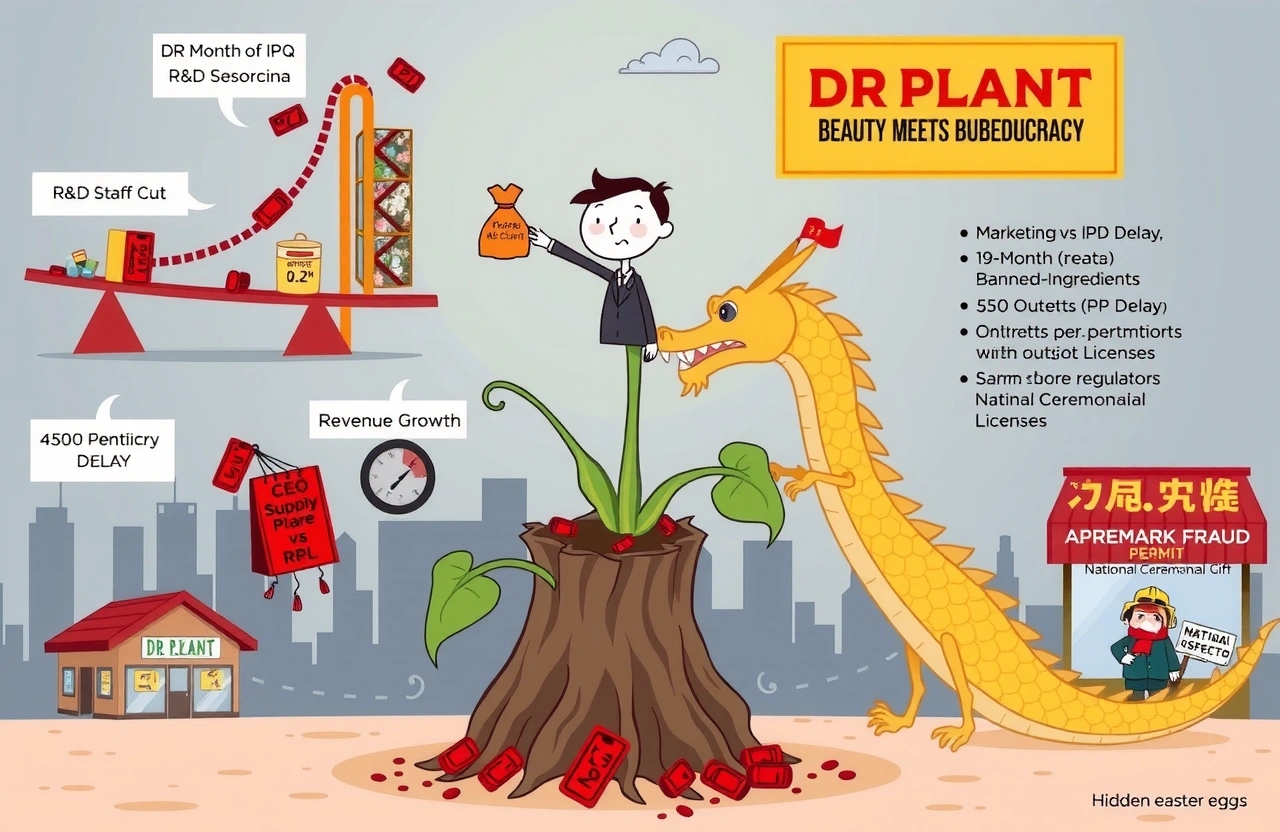IPO Dream Clouded by Regulatory Violations
Chinese cosmetics brand DR PLANT (植物医生), endorsed by superstar Wang Junkai, has ignited investor interest with its ambitious IPO filing – flaunting 4,500 stores and 14 million members. Yet beneath this glossy exterior, regulatory filings reveal alarming governance gaps and declining innovation momentum. Despite CEO Xie Yong (解勇) steering toward a landmark public listing, DR PLANT accumulated 16 penalties across China between 2022-2024 for violations ranging from false advertising to supply chain management failures. These infractions expose systemic weaknesses that threaten the company’s stability.
The contradictions run deep: While vocalizing R&D prioritization, DR PLANT quietly slashed its research team by 21% – eliminating 36 positions. Simultaneously, marketing expenditure ballooned to 10 times R&D investment, revealing misaligned priorities. As China’s beauty market intensifies, these patterns raise critical questions about DR PLANT’s IPO viability.
Summary of Key Concerns
- Regulatory non-compliance: 16 documented violations across subsidiaries
- Stagnant growth: Revenue increased only ¥5M (0.2%) in 2024
- Personnel contradictions: 21% reduction in R&D staff despite claimed innovation focus
- Financial imbalance: Marketing spending exceeds R&D budget by 10:1
- Governance gaps: 32 operational outlets lacked health permits as of May 2025
The Regulatory Crackdown
Systemic Compliance Failures
Evidence reveals deep-seated control failures across DR PLANT’s corporate structure. Beijing Minghong Yanqing subsidiary faced ¥25,000 fines for deceptive pricing, while Jiangxi Gao Zhi Mei Ji received penalties for falsifying cosmetic ingredient claims. Shockingly, internal audits confirmed 32 operational outlets still lacked mandatory health permits – violations CEO Xie Yong promised to cover personally, yet still signifying flawed oversight.
Franchisee Fallout
The damage extended beyond corporate entities. A franchise store in Chibi city was fined ¥85,000 for using prohibited chemical ‘Phenylethyl Resorcinol’ – violation highlighting supply chain vulnerabilities. Additional penalties in Sichuan province targeted stores misrepresenting products as ‘national ceremonial gifts’. Together, these incidents demonstrate DR PLANT’s inadequate compliance frameworks penetrating every operational layer.
Growth Stagnation Amid Channel Conflicts
The Sales Plateau
Beyond regulatory troubles, DR PLANT faces market stagnation. Revenues crawled from ¥21.17B (2022) to ¥21.56B (2024) – a negligible 1.8% compound annual growth. This pales against competitors like skincare brand L’Occitane (46% growth) or Yunnan-based Betenny with consistent ¥7B annual jumps. While China’s beauty sector expanded rapidly, DR PLANT’s annual ¥500K revenue climb signaled fading momentum.
Dealer Dilemmas
The sales model reveals underlying tensions. Dealership revenue slid ¥221.55M as partner count shrank from 3,999 to 3,830 stores (-4%) despite DR PLANT’s retail claims. Compounding this, company-owned stores now generate 4.5x more revenue per outlet than franchises. With 60% of sales still dealer-dependent, the widening performance gap risks partner alienation.
The R&D Paradox
Action vs Rhetoric
DR PLANT’s proclaimed ‘innovation commitment’ disintegrates under scrutiny. While claiming ‘high R&D investment’, filings show 36 research positions eliminated since 2022 – contradicting total staff growth of 259. More alarming, core technologies (like Dendrobium serum extract and Yunnan botanical research) relied extensively on third-party developers. Rather than cultivating internal expertise, DR PLANT cultivated dependence.
Resource Imbalance
The spending disparity speaks volumes: ¥743M poured into marketing representts R&D expenditure. Salesforce headcount (2,601) dwarfs researchers by 20:1 – demonstrating skewed priorities. This ‘buy over build’ strategy saved short-term expenses but forfeited proprietary innovation capacity – dangerous strategy as competitors accelerate tech development.
Governance and Financial Divergence
The Boardroom Beneficiary
Further contradictions emerge in capital allocation. Before IPO registration, DR PLANT distributed over ¥100M in dividends – overwhelmingly benefiting CEO Xie Yong who controls 79.14% ownership. Such distributions amid R&D cuts and stagnant growth hint at priorities favoring leadership interests over long-term development.
Operational Uncertainties
Persistent governance gaps complicate recovery. Supply chain volatility (evidenced by banned ingredients in franchises) combined with ongoing permitting failures weaken fundamentals for public investors. Without addressing root compliance issues first, DR PLANT risks premature listing – as evidenced by IPO delays requiring 19-month extension.
Crossroads for China’s Beauty Pioneer
DR PLANT stands at a critical inflection point: Its impressive store network and celebrity appeal contrast sharply with governance failures and strategic contradictions. The widening gap between promised vision (R&D excellence) and reality (personnel cuts, outsourcing dependence) suggests misalignment at executive levels. As investors review IPO filings, fundamental questions persist:
- Can regulatory track record improve without governance overhaul?
- Will dealer network survive direct-comparison revenue gaps?
- How to rebuild R&D credibility after visible capacity shredding?
The path forward demands concentrated governance reforms, authentic R&D recommitment, and channel balancing before market entry. Until then, DR PLANT’s IPO dreams will remain shadowed by deeper institutional uncertainties.



